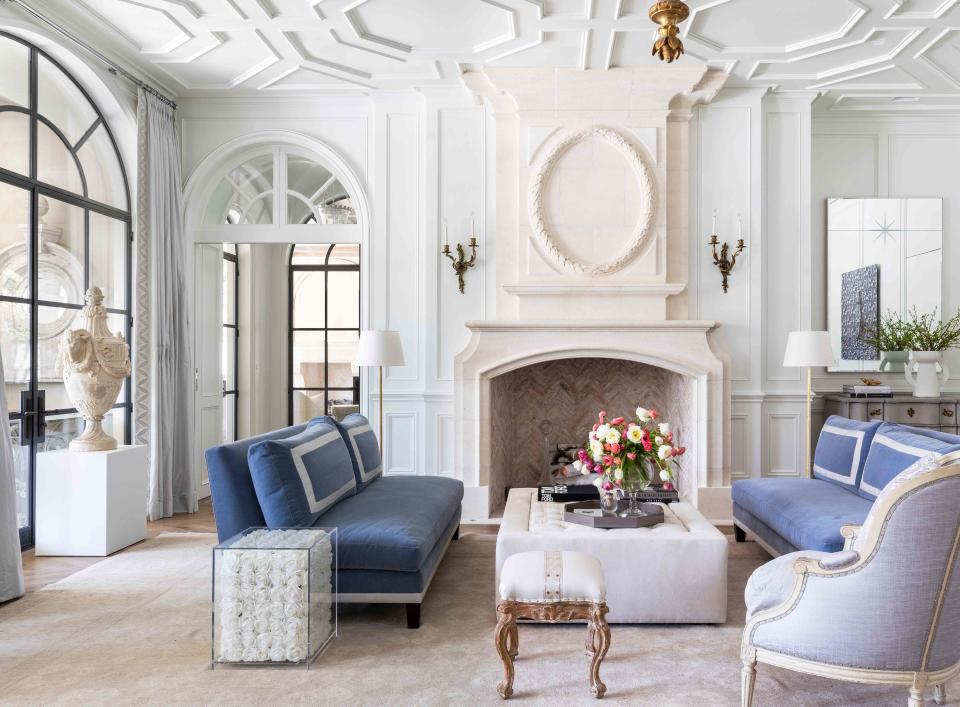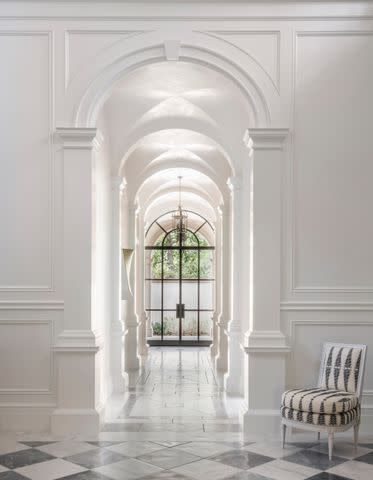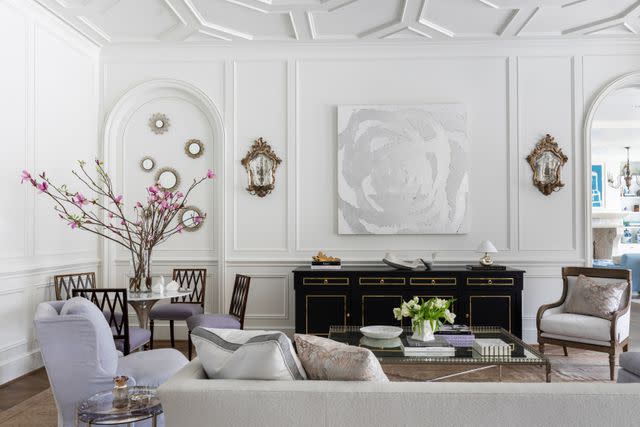Neoclassical Interior Design Is Timeless and Traditional: Get the Look
This sophisticated decorating style relies on subdued elegance.

JULIE SOEFER
As interior design trends shift away from simple, no-frills spaces to more traditional styles and decorative interiors, classical looks are re-emerging. “After a surge of minimalism, traditional spaces are like a breath of fresh air,” says Jake T. Galang, the designer behind Ilustracion by Jake, Corp. Neoclassical is among the aesthetics gaining extra attention. “Neoclassical style is timeless, ” says Galang. “It works really with today’s transitional design. It is refined but still feels luxurious."
What Is Neoclassical Interior Design?
“Historically, the neoclassical era was marked by pulling back some of the excess of Rococo,” says Kathy Kuo, interior designer and founder of Kathy Kuo Home. Rococo originated in France in the early 18th century. The asymmetrical style was bright, light, and elaborately decorative, notably with s- and c-shaped curves, detailed scrollwork, and gilding.
According to Kuo, Neoclassical style offered “a more refined and intentional minimalism” compared to Rococo. “Think classic Doric columns and Grecian-inspired details, and an emphasis on highlighting both vertical and horizontal lines,” says Kuo. These elements are evidence of an Ancient Greek and Roman architecture revival at the time. “The architectural elements influenced the interior aesthetic,” says Galang.
Jerad Gardemal
[Neoclassical design] is rooted in history, precision, and scale. The focus is on quality, clean lines, and a subdued color palette.
Neoclassical interiors mix simple geometry, like strong lines in columns and arches, with more ornate detailing, through millwork and other decorative elements. Unlike the asymmetry of Rococo, balance and symmetry are key to Neoclassical decor. "The design aesthetic is rooted in history, precision, and scale," says Jerad Gardemal, principal and founder of JF Gardemal Designs. "The focus is on quality, clean lines, and a subdued color palette. It is about symmetry, balance, and disciplined design."
The result is a look we recognize as both traditional and formal. Neoclassical interiors feel grand in appearance and scale but are sophisticated rather than ostentatious. According to Gardemal, the style is a good fit for anyone who appreciates beautiful and refined interiors with a strong history, more minimalist approaches to interior decor, and those looking to "make an impact without the fussiness" of some other design styles.
How to Get the Look
“Neoclassic is a simple version of grandiose,” says Galang. “Don’t overdo it!” The designer warns that excess can cause a space to look cheap. "It is not about trying to create period spaces, it is about trying to introduce serenely balanced components into your interiors," says Gardemal.
When it comes to embracing Neoclassical design elements, err on the side of simplicity—rather than the lavish abundance of Rococo roots—to help you achieve the look. "Neoclassical interior design is all about effortless elegance and sophisticated details,” says Kuo.

JULIE SOEFER
Arches and Columns
Prominent in the Greek and Roman architectural influences behind the style, both arches and columns are features you can rely on for nailing Neoclassical style. Architectural arches include arched doorways and windows, or arched features like a fireplace mantel.
"Neoclassical spaces are spacious and the use of large windows and door frames ensures natural light is plentiful," says Gardemal. You can also incorporate arches through furniture profiles and decorative elements like mirrors and wall molding.
Columns are another key feature. Architectural columns can provide structural support, or they can be decorative and intended to create the scale elements of Neoclassical style. Galang offers examples including pilaster columns jutting from walls, a full column used to divide rooms, and more subtle nods to the architectural element, like a column post on kitchen island cabinetry.
Symmetry and Balance
Neoclassical style relies heavily on symmetry and balance. “The balance on left and right has to be present, may it be on lighting, flooring, wall paneling, or any other interior treatment,” says Galang. In essence, if one side of a TV has a bookshelf, the other should as well. If one side of a buffet is lit with a wall sconce, so should the other.
Another example is ceiling design and floor pattern, which Galang says should reflect or at least complement one another. Though these surfaces may have architectural and decorative motifs, one should not overpower the other or have surprising uses of colors, patterns, or contrast. Galang also cautions against out-of-scale accents, like moldings and furniture, which can prevent the space from reaching that Neoclassical level of refinement and balance.
Although a room’s proportions may be difficult to change in an existing space, Galang recommends ensuring the layout is symmetrical if you’re building new or starting from scratch.

Christopher Lee / Courtesy of Illustracion by Jake
Muted Colors
Neoclassical colors are typically natural and light, particularly utilizing neutrals. “Think cream, taupe, moss green, and stone blue,” says Kuo. These lighter colors not only minimize contrast, they help a space feel bigger and contribute to that sense of scale.
To accent soft neutrals, Galang recommends gold, gray, green, red, or black, as well as the use of natural stone and stone-look patterns. “Calacatta Gold, Bianco Carrara, or Noir St. de Laurent [marbles] or any other stone that reflects the Greco-Roman period,” says Galang.
Millwork
Millwork is a major component of Neoclassical interiors. In addition to baseboards and crown molding, Galang says this elevated style embraces raised and recessed paneling, and doorways outfitted with molding. Picture frame molding (also called box trim) is especially popular for the style, either in simple lines or with more dramatic flourishes.
Bare, otherwise unadorned walls are welcome when millwork and other accents are used. The simplicity balances the otherwise ornate details, even when the wall color and trim color are the same.
Related: Millwork Is Having a Moment in 2023

JULIE SOEFER
Fine Furniture
“Neoclassical design is kind of the opposite of trendy. It goes hand in hand with quality craftsmanship and a subtlety that is easy to mix and match different decor pieces with," says Kuo. “Add neoclassical charm with pieces like accent chairs that have a sleek silhouette, luxe upholstery, and a walnut (or similar dark wood) frame.”
A low velvet sofa on caster legs is one example while a high-backed upholstered chair with a subtle pattern and wood accents is another option. Many antique pieces are at home in Neoclassical spaces. Just don’t forget that, though a large scale is encouraged in Neoclassical spaces, the furniture should be suitably sized to fit the room; oversize pieces offset the balance.
Decorative Accents
Attention to detail pays off in upscale traditional styles like Neoclassical, and there are numerous opportunities to incorporate decorative elements.
Galang recommends classical Roman and Greek motifs like anthemion, fleur-de-lis, Greek key, and beading, as well as damask and geometric prints. According to Galang, these shapes and patterns can be incorporated through anything from architectural hardware, like cabinet hinges, door knobs, fabrics, and wallpaper.
Mirrors, window treatments, antique chandeliers, and other decorative features are also encouraged in Neoclassical design. Galang says urns and art prints that feature porticoes are examples of period-appropriate decor that can be incorporated into today's interior designs.
For more Better Homes & Gardens news, make sure to sign up for our newsletter!
Read the original article on Better Homes & Gardens.

